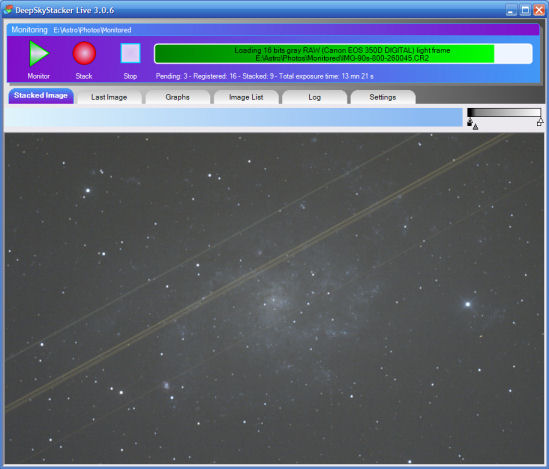DeepSkyStacker Live User's Manual
Introduction
Quick Start
Settings
Graphs
Technical Information
Introduction
What is DeepSkyStacker Live?
DeepSkyStacker Live is designed to be used in the field
during an imaging session for the following tasks:
- Aligning and stacking the images as they are
captured.
- Computing and showing statistics on the
incoming images (FWHM, number of detected stars, drifting...)
- Showing the stacked image
- Issuing warnings when some conditions are met
like when the drifting is greater than some user defined value
DeepSkyStacker Live is compatible with any
capturing device (DSLR, CCD Camera) and any software as long as the captured
images are created in a folder and are of a recognized file format (FITS, TIFF,
JPEG and most RAW images from DSLRs).
Side note: DeepSkyStacker Live is not replacing DeepSkyStacker.
They are using the same engine but DeepSkyStacker Live does not have all the
features that are needed to create images that can be post-processed accurately.
For example it is not possible to calibrate the images (dark and bias
subtraction and flat division) or to use the most advanced stacking methods
(kappa sigma or adaptive weighted average) with DeepSkyStacker Live.
DeepSkyStacker Live User Interface
|
Like DeepSkyStacker the user interface of
DeepSkyStacker Live is quite simple and intuitive and all the main features and
commands are
readily available.
On top of the screen three buttons are used to start monitoring, start
stacking and stop.
The bottom part is used to monitor the progress during the imagining session
from different point of views:
The last tab is used to set
the parameters controlling the behavior of DeepSkyStacker Live.
|
 |
Quick Start
Your laptop is all set for the night imaging session, the CCD or
DSLR capture software is up and running.
Start DeepSkyStacker Live, click on the Stack
button, and select the monitored folder. That's it!
From now on all the images created in the monitored folder will be registered,
aligned and stacked unless they match some specific condition that you have set
in the Settings tab.
Of course you can change the
settings while DeepSkyStacker Live is monitoring the incoming files.
Settings
First of all, DeepSkyStacker Live is sharing all the settings
concerning image decoding, star detection threshold, alignment methods and
background calibration options with
DeepSkyStacker. To change these values you must use DeepSkyStacker.
The only difference is that AHD and Bayer Drizzle are automatically transformed
to bilinear interpolation.
The Settings tab is used to define when the incoming images will be stacked,
when to issue a warning and how the warnings are issued.

Stacking
options
Don't stack until at least xxx images are available
This option may be used to wait for a minimum number of images before
deciding which image will be used as the reference frame.
When the minimum number of images is available DeepSkyStacker Live will use the
one with the highest score as the reference frame.
This option is especially useful if you are taking short exposures and if you
are not sure that all you light frames are good enough.
Warn/Don't stack options
These options are self explanatory and can be used to set various conditions
for which an image should not be stacked and/or a warning should be issued.
It is possible to set conditions on:
Warnings
When a warning condition is detected it is possible to be noticed using four
different ways:
-
Sound: the classic bip of the computer
-
Flash application: DeepSkyStacker Live is
flashing 4 times
-
Create a warning file: a file named
DSSLiveWarning.txt containing the warning message is created in the folder of
your choice. It can be a local folder or a network folder. If the file already
exists the new warning message is appended to it.
-
Send email: an email containing the warning
message is send to the address of your choice.
In the email configuration dialog box you can choose to send a email only for
the first warning. In this case as soon as an email has been sent a reset button
will appear to let you reset the email internal counter.
Stacked Image creation
The stacked image is only created in memory and is not saved by default.
This option may be used to create a file containing the stacked image each time
xxx images are added to the stack.
The stacked image is saved in a file named Autostack.tif in the folder of your
choice. If the file already exists it is overwritten.
It is always a 16 bit TIFF image and depending on the incoming images it can be
color or grayscale.
Graphs
For each image DeepSkyStacker Live is using the following
symbols:
-
A green circle for each
processed image
-
An orange circle behind
the green circle: a warning condition is met
-
A red triangle on top
of the green circle: a don't stack condition is met
-
A green square is used
in the dX/dY and Angle graphs to represent the reference frame
About the dX/dY graph: the
red line is representing dX and the
blue line is representing dY.
When an image is not stackable it
does not appear in the dX/dY and Angle graphs.
Technical information
DeepSkyStacker Live is using the Average stacking method (this is
the only method that can be used when the number of images is not known in
advance).
Since no calibration is possible a simple hot pixels detection and removal is
used on the incoming light frames before stacking them.
You can see the hot pixels in the Last Image tab, but they should be removed in
the Stacked Image.
Contrary to DeepSkyStacker, DeepSkyStacker Live is using one processor for all
the background tasks (loading, registering, stacking) even if more than one is
available.

